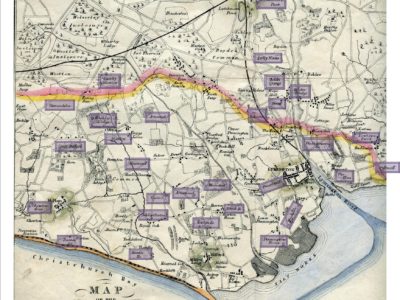
Pylewell Park appears to have been owned by the Worsley family from at least 1646. By 1670 Sir James Worsley declared that he owned ‘one ancient capital messuage or tenement called Pilewell and 90 acres of land … within the forest.’ The property remained with the Worsley family until 1780, when it was bought for £22,000 by Ascanius William Senior. At this time it included the manors of Pilley and Warborne and farms including Vinings, East End, Walhampton, Pitts Deep, Nash and Blackhamsley. By 1784 Senior had also bought South Baddesley, creating a much larger estate based on Pylewell.
There is evidence that a different landscape was created in the late 18th century under Thomas Robbins, who bought the house in 1787. A new scheme of informal parkland and ornamental walks was introduced, in keeping with the naturalistic look fashionable at the time. It was designed in the style of ‘Capability’ Brown, although not by him. Richard Warner, an historian and clergyman whose observations of the English countryside were inspired by William Gilpin, wrote of Pylewell: “The grounds around it are laid out with great simplicity; an extensive lawn, belted by a shady walk, with occasional openings, stretches from the house to the seaside”.
Joseph Weld took possession of Pylewell in 1801-2, possibly as a gift on his wedding. His family were from Lulworth in Dorset and he later inherited the family estates there. Pylewell was well-placed for his interest in yachting but the income from the estate was considerable and paid for the extensive improvements made to the house between1810-1815. Weld was clearly very fond of Pylewell writing from Yorkshire ‘I long to be back’.
He became actively involved in estate improvements, taking a close interest in the details of stock, fences and crop rotation. When his other estates and business took him away, he wrote to the land agent Mr Wood asking for information and offering advice on the minutiae of estate affairs. “How will our Turnips last? How does the Wheat look? I suppose you will be able to give some of it a dressing.” Weld also made extensive improvements to the gardens, including the development of the North Park and the construction of South Lake in 1822.
A survey of the Estate was carried out in 1803, after it was bought by Thomas Weld. It consisted of about 1,950 acres, of which the house and grounds amounted to nearly 150 acres of woods, lawn and meadow. Common land and freeholders occupied roughly 550 acres, with tenanted farms and cottages on the remaining 1,250 acres. The largest tenanted farms were Vinings, Lisle Court, Norley, Walter’s and Blackhamsley.
An account of the grounds in 1845 stated: “the manor is well stocked with game and is in a high state of cultivation. The gardens, which are on a large scale, are kept in fine condition, and produce every delicacy of the vegetable world which the most fastidious taste can desire”. A letter of 1809 from Thomas Aberbnethy, Pylewell gardener to Charlotte Weld confirms this: “I have sent by the Caravan two hundred and a half of Sparrowgrass (asparagus), two brace Cucumbers, Potatoes, Radishes, etc. I can send some kidney beans and other vegetables next week if you think it proper.”
The Welds found that the proximity of the road and a small chapel lying 130 yards from the house both a nuisance and a barrier to extending the park north of the house. They gained permission to reroute the road from Lymington to East End and Baddesley to its current position. In 1818 Joseph also agreed to rebuild the chapel at his own cost, in the village of Baddesley where it still stands.
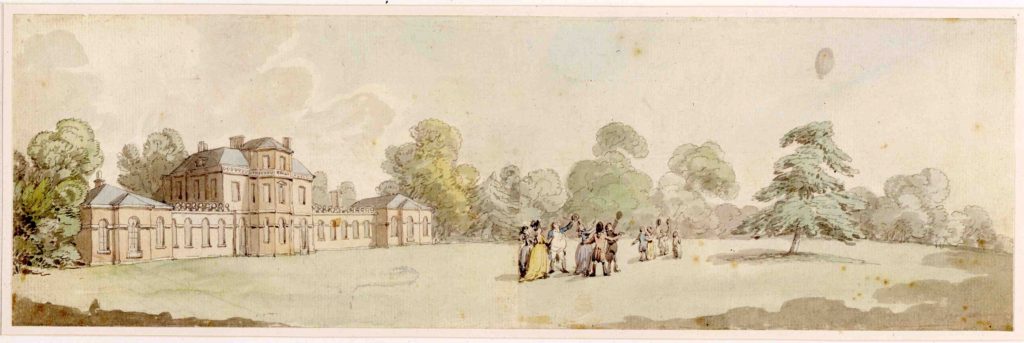
The earlier chapel was demolished. The Weld’s were Roman Catholic themselves, and by 1806 had built a private chapel at Pylewell with a Jesuit chaplain, Father John Alloway, in attendance. Joseph Weld stopped living at Pylewell in 1841 preferring ‘The Lodge’ (or Blake’s Lodge) on the Walhampton side of the river so he could have easy access to the river for yachting. He opened a public chapel there and it was used for 40 years, even after the opening of Our Lady of Mercy and St Joseph in Lymington.
By 1874, when William Ingham Whitaker bought the estate, it was a substantial property. The auction details described it as follows: “The living rooms include an Entrance Hall, Drawing Room, Ante Room, Dining Room, Library, Conservatory, Morning Room, Business Room, Sitting Room, Music Room, Ladies Boudoir on the first floor and Smoking Room in the Basement. A massive oak staircase led from the sleeping apartments, consisting of 15 bedrooms and drawing rooms, a nursery, governess’s room, a ladies maid’s room, and 10 secondary and servants’ bedrooms. The domestic offices consisted of a housekeeper’s room, servant’s hall, housemaid’s room, large kitchen, and extra room, 5 bedrooms, a butler’s pantry, lamp room, scullery, 3 larders, a bakehouse, 2 wine cellars, a beer cellar, a dairy and washing rooms. Outside were stables and coach houses, etc.”
Whitaker made major alterations to the gardens in the first half of the 20th century. A new lily pond was created and the wooden Japanese Bridge was constructed, designed to give a feeling of transition within the landscape. A new lake was dug and a collection of rhododendrons established on its banks between 1912 and the early 1920s.
New parterres were laid out on the south-east front with balustraded ha-has, and the pleasure grounds were developed with Asian and Australian plant collections, brought back from his travels to the Far East. Ha-has, or concealed ditches, were built to dissuade deer and cattle from encroaching on the lawns, at the same time providing uninterrupted views from the house. By the early 1920s the gardens had reached their most elaborate stage, employing 40 gardeners. Minor additions were made to the terrace walk gardens to the east of the house in the 1960s, and the parterres on the south-east front were simplified. The walled garden was leased as a commercial nursery.
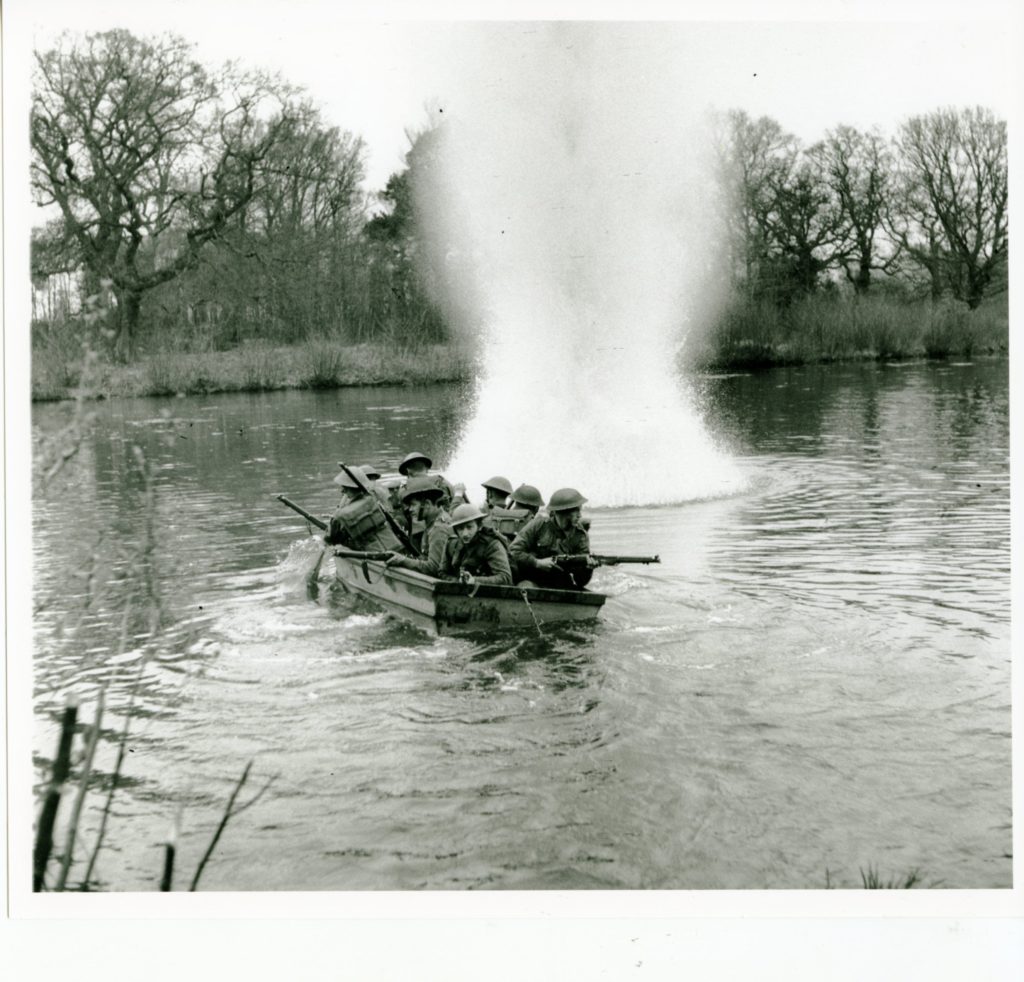
Pearl Gregory, born in 1922 at Furzey Lodge, by Hatchet Pond recalls: “Old Mr and Mrs William Whitaker employed a lot of people. They were lovely gentlemen. It was a lovely great big estate house, I can remember going round to the back, called the bothy and getting pounds of beef dripping.” Pearl also remembers “We used to have all our sports down in the grounds, all the schools around used to come there for sports day. I used to be in the netball team and a runner. That used to be a lovely day.”
Pylewell Park was requisitioned at the beginning of the War and used by the 47th Division; the house became the barracks and the grounds were used as a training camp. Meanwhile, the Roper-Curzon family were moved out to Home Farmhouse and later to Lisle Court. John Roper-Curzon, Lord Teynham, who was a young boy at the time, remembers having his ID checked by a ‘huge giant of a GI every time I left and returned to the cottage.’ After the 47th Division left, Pylewell was taken over by American forces and later by Italian Prisoners of War.
Pylewell has long and fascinating history – see more in the gallery below.

Pylewell Park in 1700. LMGLM:1999.1.19 
Pylewell Park appears to have been owned by the Worsley family from at least 1646. By 1670 Sir James Worsley declared that he owned “one ancient capital messuage or tenement called Pilewell and 90 acres of land … within the forest.” LMGLM:2004.2.83 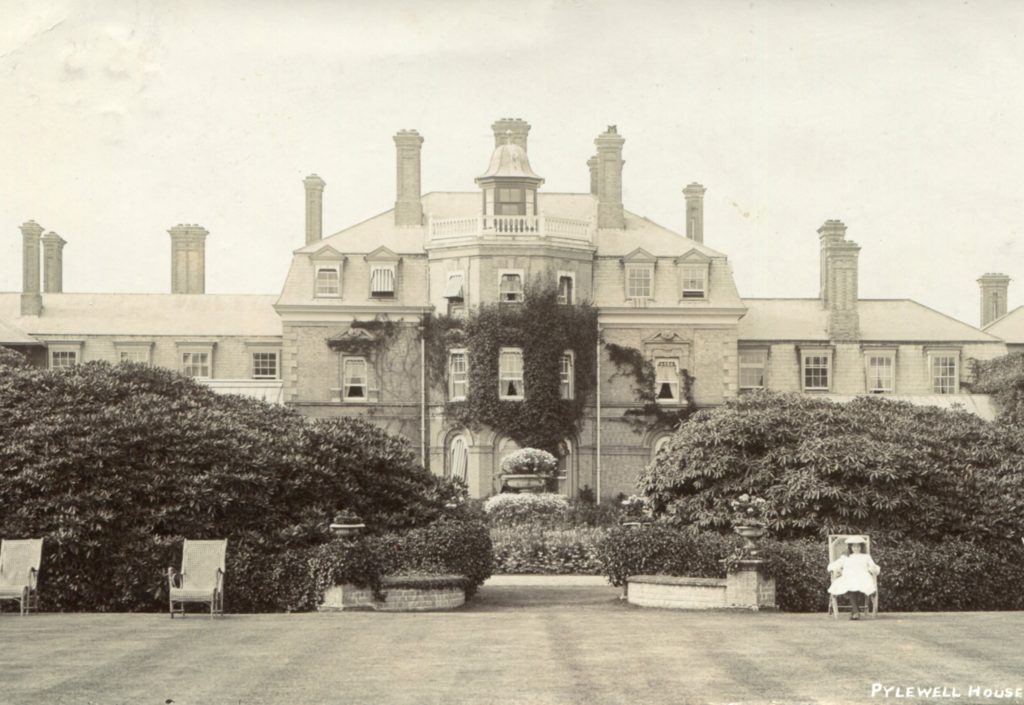
Postcard of Pylewell House, postmarked 10th November 1905. LMGLM:2011.121.15 Courtesy of Chris Hobby 
Front entrance at Pylewell Park with the wings added by the first William Whitaker and as it appeared until the 1950s. LMGLM:2011.121.29 Courtesy of Chris Hobby 
Postcard of Pylewell Houses rear elevation and gardens, postmarked 7th December 1908. LMGLM:2011.121.19 Courtesy of Chris Hobby 
Primrose League Fete at Pylewell. The Primrose League was established in 1883 to promote Conservative principles. At its height in the 1890s, it had over a million members but it was disbanded in 2004. Its name was chosen because the primrose was the favourite flower of Tory Prime Minister Benjamin Disraeli. LMGLM:2011.121.23 
Primrose League Fete at Pylewell. LMGLM:2011.121.20 
Primrose League Fete at Pylewell. LMGLM:2011.121.21 
Primrose League Fete at Pylewell. LMGLM:2011.121.22 
The groom at Pylewell with a couple of their horses. LMGLM:2011.121.27 Courtesy of Chris Hobby 
Stableyard with staff and animals. LMGLM:2011.121.25 Courtesy of Chris Hobby 
Stable workers at Pylewell. LMGLM:2011.121.28 
Pylewell Park Gardens. LMGLM:1998.256.2 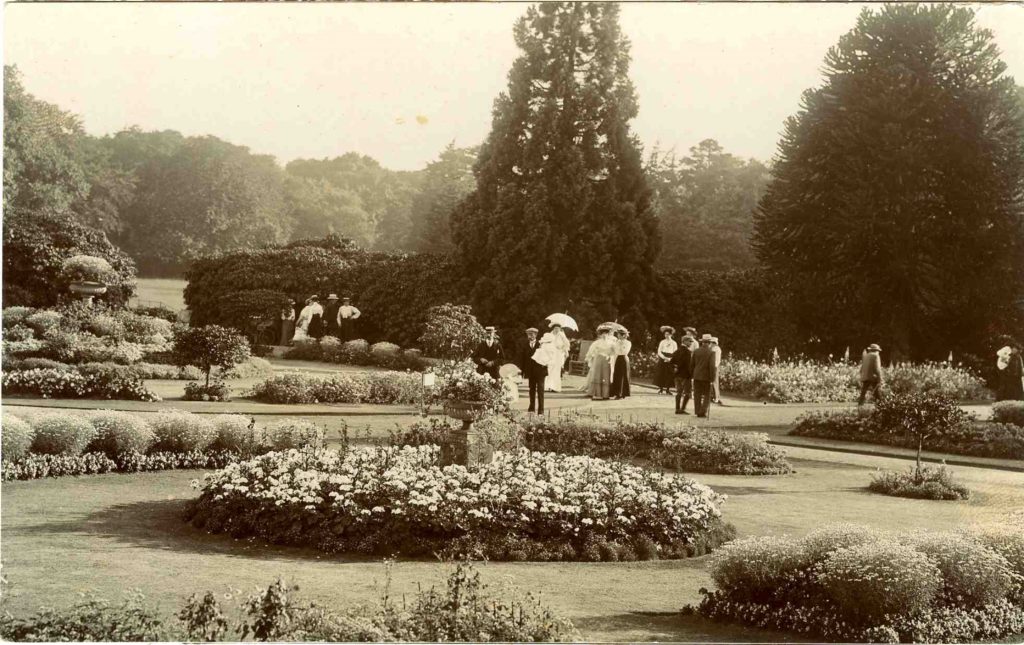
The gardens at Pylewell, 1910-1919. LMGLM:1998.256.3 
The lake at Pylewell in about 1908. LMGLM:1999.239.24 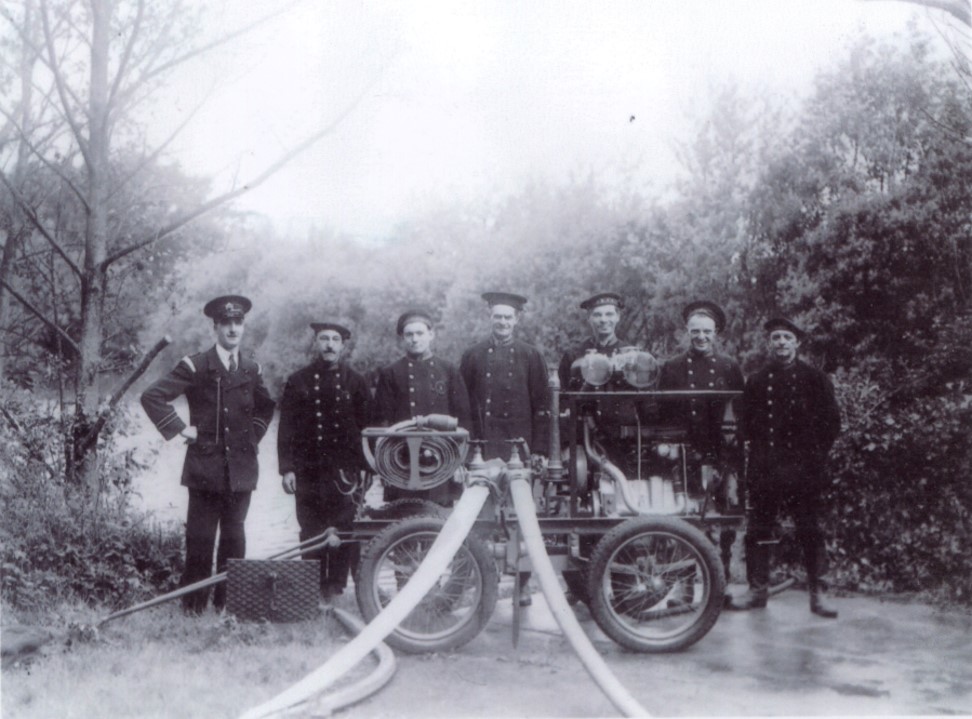
Pylewell Park even had its own fire brigade, manned by workers on the estate. The daughters of William Whitaker remembered it: “It was a wonderful sight. One can’t imagine great cart horses galloping but the poor things were made to gallop long distances pulling the fire engine behind them”. It was used in 1910 to put out a fire in the house itself which, according to a report in the Lymington Chronicle, was caused by a fire in the engine room and resulted in £1,500 worth of damage. Courtesy of the Boldre Parish Historical Society. 
The Pryer family. Mr Pryer was manager of the Pylewell Park Estate and lived in Pylewell Cottage. His first wife died giving birth to triplets and he later married the nanny. Mr Pryer died in 1960 aged 84. LMGLM:1998.256.12




